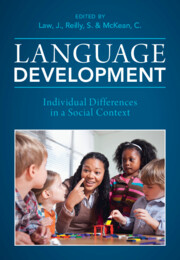Book contents
- Language Development
- Language Development
- Copyright page
- Contents
- Figures
- Tables
- Contributors
- A Tribute to Our Friend, Colleague and Fellow Editor, Professor James Law
- Introduction
- Part One Factors Influencing Language Development
- 3 Genetic Studies of Language Disorders
- 4 Hearing and Language
- 5 Co-occurrence between Language Disorders and Common Conditions in Childhood
- 6 Language and Cognition
- 7 Growing Up in Multilingual Communities
- 8 Parent–Child Interaction and Its Impact on Language Development
- 9 Cognitive Competencies and Signals of Risk
- 10 Creating Equitable Opportunities for Language and Literacy Development in Childhood and Adolescence
- Part Two Continuity and Change
- Part Three Impact, Intervention and Equity
- Index
- References
5 - Co-occurrence between Language Disorders and Common Conditions in Childhood
from Part One - Factors Influencing Language Development
Published online by Cambridge University Press: 11 August 2022
- Language Development
- Language Development
- Copyright page
- Contents
- Figures
- Tables
- Contributors
- A Tribute to Our Friend, Colleague and Fellow Editor, Professor James Law
- Introduction
- Part One Factors Influencing Language Development
- 3 Genetic Studies of Language Disorders
- 4 Hearing and Language
- 5 Co-occurrence between Language Disorders and Common Conditions in Childhood
- 6 Language and Cognition
- 7 Growing Up in Multilingual Communities
- 8 Parent–Child Interaction and Its Impact on Language Development
- 9 Cognitive Competencies and Signals of Risk
- 10 Creating Equitable Opportunities for Language and Literacy Development in Childhood and Adolescence
- Part Two Continuity and Change
- Part Three Impact, Intervention and Equity
- Index
- References
Summary
Language difficulties are common and appear to occur at higher rates in children with neurodevelopmental and mental health conditions. This chapter focuses on understanding the overlap between language difficulties and (1) autism spectrum disorder (ASD), (2) attention-deficit/hyperactivity disorder (ADHD) and (3) internalising and externalising and externalising difficulties. We use data from cross-sectional and longitudinal designs to examine the associations between these conditions in both clinical and population-based research. Language difficulties were more common than expected across all contexts, suggesting these are important in the assessment and treatment of these disorders. However, there is variation in how much language difficulties are considered in clinical practice across these conditions. In the area of ASD, language difficulties are often a key consideration, whereas for ADHD and internalising and externalising difficulties, language difficulties tend not to be routinely considered. Here we point to the need for language-based services to consider other developmental and mental health conditions, and the need for mental health services to consider the potential presence of language difficulties. We recommend that research examines how to better support children with language difficulties to prevent the development of future internalising and externalising difficulties.
- Type
- Chapter
- Information
- Language DevelopmentIndividual Differences in a Social Context, pp. 100 - 121Publisher: Cambridge University PressPrint publication year: 2022

